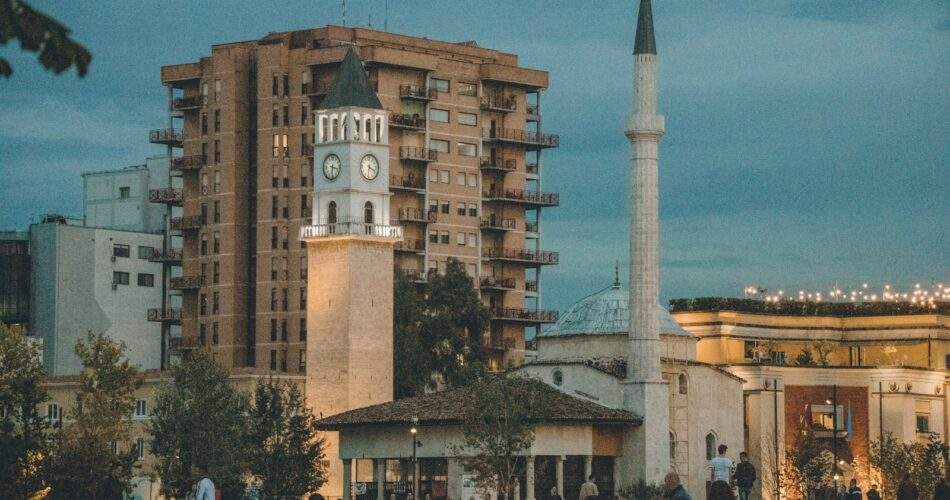Tirana announces itself boldly through kaleidoscopic apartment blocks painted in oranges, pinks, and yellows—a deliberate act of defiance against its gray communist past. Albania’s capital is a city in constant conversation with itself, where Italian-built neoclassical façades stand alongside brutalist bunkers, where calls to prayer drift over espresso-fueled sidewalk debates, and where Europe’s youngest population has created an energy that feels both familiar and entirely its own. This isn’t a polished, tourist-ready capital. It’s raw, affordable, and unabashedly authentic—a city where you’ll stumble upon contemporary art galleries in former bomb shelters and where locals still gather nightly for the xhiro, the evening promenade that turns the city center into a open-air social club.
The sweet spot for visiting Tirana falls between late April and early June, when jacaranda trees bloom purple along Lana River and temperatures hover comfortably between 20-25°C. The city feels alive during these months without the peak summer intensity. September through mid-October offers similar conditions with the added benefit of harvest season flavors appearing on restaurant menus. Summer (July-August) brings heat that often exceeds 35°C, though locals escape to nearby beaches, leaving the city pleasantly quiet for those who don’t mind the warmth.
Winter receives few visitors, and while temperatures rarely drop below freezing, the gray skies can feel oppressive in a city still building its indoor cultural scene. However, December brings Tirana’s Christmas market to Skanderbeg Square, and accommodation prices drop by half. March can be unpredictable with spring showers, but it’s an excellent time for budget travelers. If you’re planning around cultural events, the Tirana International Film Festival in late September draws regional filmmakers, while the spring Tirana Art Week showcases the city’s thriving contemporary art movement.
Begin at Skanderbeg Square, the vast pedestrian heart where Tirana rebuilt itself after communism. The Et’hem Bey Mosque, with its delicate frescoes barely visible from outside, survived the atheist regime by sheer luck—it was declared a cultural monument. Nearby, the National History Museum’s socialist-realist mosaic spanning its entire façade tells you everything about where this city has been. But Tirana’s most affecting sites sit underground and in the hills. Bunk’Art 1, tucked into a massive Cold War bunker beneath Mount Dajti, transforms Enver Hoxha’s nuclear shelter into a haunting multimedia journey through Albania’s isolation years. Its sister site, Bunk’Art 2, occupies the former Ministry of Internal Affairs building downtown and focuses specifically on the surveillance state and political persecution.
For a different perspective, wander the Blloku neighborhood, once forbidden to ordinary Albanians as the party elite’s private compound. Today it’s Tirana’s trendiest quarter, packed with boutiques and cocktail bars occupying former officials’ villas. The old bazaar area around Avni Rustemi Square retains its Ottoman-era trading spirit, where you’ll find coppersmiths and traditional qeleshe hat makers alongside vegetable vendors. Here’s what few guidebooks mention: take the twenty-minute cable car journey up Mount Dajti at sunset. Locals treat this as an evening outing, not a tourist excursion, and the rotating restaurant at the top offers views across the Adriatic on clear days—assuming you can tear yourself away from watching Tirana’s lights flicker on below.
Albanian cuisine centers on simple preparations that let ingredients speak. Byrek, the flaky phyllo pie stuffed with cheese, spinach, or meat, appears at breakfast tables and street corners alike. Tavë kosi—baked lamb in tangy yogurt sauce—is Albania’s national dish, though you’ll find it prepared differently at every restaurant. Fergese, a rich pepper and cheese skillet, varies by region; Tirana’s version often includes liver. The mountain-influenced cooking means lots of grilled meats, fresh sheep’s cheese, and ajvar-style pepper spreads. For authentic atmosphere, Oda restaurant serves traditional recipes in a setting that recreates an old Albanian stone house. The Mullixhiu team sources hyperlocally and changes their menu with Albanian seasons. Don’t miss Tirana’s café culture—locals take their macchiato seriously, and places like Komiteti serve it alongside house-made raki in beautifully cluttered vintage interiors.
The compact city center around Skanderbeg Square puts you within walking distance of most attractions and offers the densest concentration of restaurants and nightlife. Blloku appeals to younger travelers seeking the bar scene, while the area near the Grand Park (Parku i Madh) offers quieter, more residential streets with good access to green space. The New Bazaar neighborhood gives you authentic daily life and better value, though it’s grittier and less polished than central options.
Whether you’re drawn by history, affordability, or simple curiosity about Europe’s last unturned stone, Tirana rewards the open-minded. Start planning your visit through Cityraze to discover accommodations and experiences that match your travel style.
